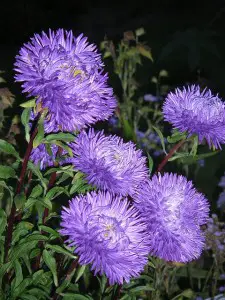Asters have been the most popular annual flowers for decades. They bloom brightly, profusely and for a long time. But the downside is that asters are prone to viral and fungal diseases. Because of this, their decorative effect decreases, the flowers are deformed, the leaves dry. To prevent this from happening, grow disease-resistant varieties, follow the rules of agricultural technology, fight pests (they are carriers of viruses) and weeds, and inspect plantings regularly.

The most common aster diseases:
Fusarium or Fusarium wilt of asters
One of the most dangerous diseases. The causative agent, which, the Fusarium fungus, lives in the soil for many years. Plants become infected through the soil in which the fungus lives. Infection occurs during budding and flowering. Young plants do not get sick with Fusarium.
Signs of infection.
The main sign of Fusarium infection is damage to the stem on one side (dark stripes form). At first, the leaves turn yellow, then darken, after which they curl and wither. Dark brown oblong spots appear on the stems. The root neck also darkens. Sometimes the stems crack. Plant growth stops, they wither and die. Sometimes (at high humidity and temperature) a pink coating appears on the lower part of the stem and leaves. Fusarium only affects annual asters.
What to do?
Change the planting site annually, that is, observe crop rotation. Asters can be planted in their original place no earlier than after five years. We recommend disinfecting the seeds before sowing in a solution of foundationazole. If you have acidic soils in your area, make them known. Spray the planted plants with a solution of copper oxychloride (0.5%). Remove affected plants from beds and burn. Sprinkle the ground where they grew with lime (quicklime).
Blackleg
Fungal disease asters. The fungus lives and winters well in the soil. Attacks plants growing in acidic soil.
Signs of infection.
Asters seedlings are more often affected, seedlings turn black, starting from the root collar. Later, the stem turns black, dries up, the plant falls and dies.
What to do?
A common cause of infection is thickened crops and waterlogging. Perform a dive in time. The soil, before sowing seeds, disinfect with a solution of potassium permanganate and copper sulfate. The soil in the garden can be disinfected by watering the infusion of onion peel (pour 1 liter of water with 30 g of onion peel and leave for a day, then strain and spray the soil two to three times a week). Remove diseased plants and destroy.
Rust astr.
Fungal disease. It affects not only asters, but also coniferous plants.
Signs of infection.
In summer, swollen spots form on the leaves of asters, which contain spores of the fungus. After some time, the affected leaves dry up and die. If coniferous trees grow near your site, then asters are at risk. The spores of this fungus are easily carried by the wind, even over long distances.
What to do?
For prevention, spray asters with a solution of lime and sulfur. If the air temperature is below 18 ° C, then spray the plants with Bordeaux mixture once a week.
Jaundice asters.
Viral disease. The carriers of this virus are insects, mainly aphids.
Signs of infection.
At first, the veins on the leaves turn yellow, later the entire leaf turns yellow. The plant stops growing and does not bloom. The buds are green in color.
What to do?
Fight pests, as they are the ones who spread the disease. Plants with the first signs of damage, remove and burn. In pest control, yarrow infusion gives a good result.
Published: 07/08/2014

One thought on “Diseases of asters. How to identify and cure … – planting, care, photos, how to grow and harvest”